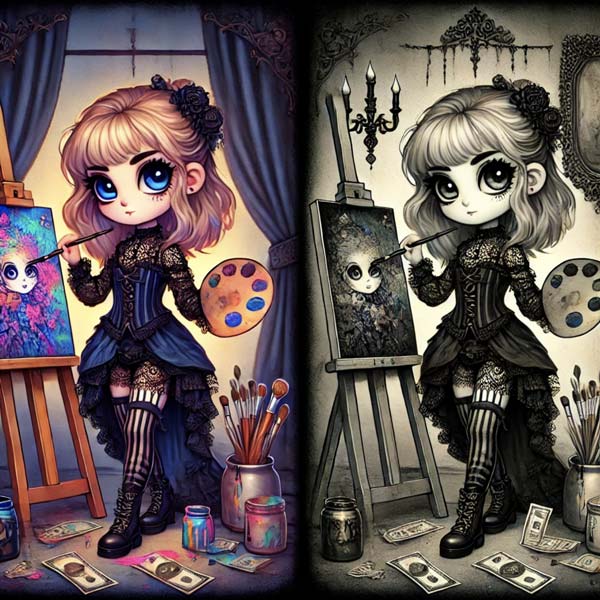
The term “selling out” has long been a contentious issue within the art world. It conjures images of artists betraying their creative integrity for financial gain, raising questions about the true value of art in a commercialized society. This topic becomes even more relevant today as the line between art and commerce blurs further. This article explores the history, motivations, ethical considerations, market impact, audience perceptions, legal aspects, and future trends of artists working with big brands.
Artist-brand collaborations are not a new phenomenon. The relationship between art and commerce can be traced back to the Renaissance when artists like Michelangelo and Leonardo da Vinci received commissions from wealthy patrons, including the Church and the nobility. These early partnerships laid the foundation for modern-day artist-brand collaborations, highlighting that financial support from powerful entities has always been integral to the art world.
As the 20th century progressed, the nature of these collaborations evolved. Pop artists like Andy Warhol famously blurred the lines between art and consumerism, producing works that celebrated and critiqued commercial culture. Warhol’s partnership with brands like Campbell’s Soup demonstrated that art could thrive in the commercial realm without necessarily losing its critical edge. This period marked a significant shift in how artist-brand collaborations were perceived, setting a precedent for future engagements.
In the late 20th and early 21st centuries, the advent of global capitalism and mass media further transformed these collaborations. Artists began working with fashion houses, technology companies, and lifestyle brands, reaching wider audiences than ever before. These partnerships were often mutually beneficial, providing artists with financial stability and brands with cultural cachet. This era saw a redefinition of “selling out,” with many artists embracing commercial opportunities as a legitimate extension of their practice.
Today, the landscape of artist-brand collaborations is more dynamic and diverse than ever. With the rise of digital platforms and social media, artists can engage directly with their audiences and collaborate with brands in innovative ways. These developments challenge traditional notions of artistic integrity and commercial exploitation, prompting a reevaluation of what it means to “sell out.”
Modern Examples of Artist-Brand Collaborations
One of the most iconic examples of a successful artist-brand collaboration is the partnership between Japanese contemporary artist Takashi Murakami and luxury fashion house Louis Vuitton. Beginning in 2003, Murakami’s vibrant, playful designs rejuvenated Louis Vuitton’s brand image and brought his art to a global audience. This collaboration proved that art and fashion could coexist harmoniously, enhancing the cultural value of both.
Similarly, street artist KAWS has collaborated with numerous brands, including Nike, Uniqlo, and Dior. His distinctive style, characterized by bold colors and cartoon-like figures, has made him a favorite among both art collectors and fashion enthusiasts. These collaborations have not only expanded KAWS’s reach but also demonstrated the commercial viability of street art in high fashion and mass-market retail.
Another noteworthy example is Yayoi Kusama’s partnership with Louis Vuitton. Known for her polka-dot patterns and immersive installations, Kusama’s collaboration with the luxury brand in 2012 included a range of products featuring her signature motifs. This partnership showcased how an artist’s unique vision could be seamlessly integrated into commercial products, creating a line that was both artistically significant and commercially successful.
These modern examples highlight the diverse ways in which artists and brands can collaborate. Whether through limited-edition products, fashion collections, or immersive installations, these partnerships demonstrate that the intersection of art and commerce can be both innovative and profitable. By examining these case studies, we can gain a deeper understanding of the motivations and outcomes of such collaborations.
Financial incentives are often a primary motivation for artists to collaborate with big brands. These partnerships can provide significant revenue streams, allowing artists to fund their projects and sustain their practice. In an industry where financial stability is often elusive, the opportunity to work with a well-established brand can be highly attractive.
Creative freedom is another crucial factor. Many brands are willing to give artists substantial creative control over their collaborations, resulting in products that genuinely reflect the artist’s vision. This level of creative autonomy can be appealing, as it allows artists to explore new mediums and reach wider audiences without compromising their artistic integrity.
Exposure and audience reach are also significant motivations. Collaborating with a major brand can introduce an artist’s work to new demographics and geographies. This expanded visibility can lead to increased recognition and opportunities, both within the art world and beyond. For many artists, the chance to connect with a broader audience outweighs any concerns about “selling out.”
Mutual influence plays a crucial role in these collaborations. Brands benefit from the credibility and cultural relevance that artists bring, enhancing their image and appeal. Conversely, artists gain from the association with well-known brands, which can elevate their status and legitimacy. This symbiotic relationship underscores the potential for artist-brand collaborations to be mutually beneficial, rather than purely exploitative.
Ethical and Artistic Considerations
The debate over the integrity of art when it intersects with commercial interests is long-standing. Critics argue that collaborating with brands can compromise an artist’s authenticity, reducing their work to mere commodities. This perspective suggests that true art should be free from commercial influence, maintaining its purity and independence.
Artists themselves often have varying views on this issue. Some embrace the opportunities that come with brand collaborations, seeing them as a natural extension of their creative practice. They argue that these partnerships do not necessarily dilute their artistic vision but rather provide new platforms for expression. Others, however, remain wary, fearing that commercial ties might overshadow their artistic integrity.
The balance between artistic vision and commercial viability is a delicate one. Successful collaborations often strike this balance, allowing artists to maintain their unique voice while creating commercially appealing products. This requires careful negotiation and mutual respect between artists and brands, ensuring that both parties’ interests are aligned.
Despite these considerations, the stigma of “selling out” persists. Some critics and audiences remain skeptical of artist-brand collaborations, viewing them as betrayals of artistic principles. However, as these partnerships become more commonplace and culturally accepted, the notion of “selling out” continues to evolve. This shift reflects broader changes in how art and commerce intersect in contemporary society.
The Impact on the Art Market
Artist-brand collaborations can significantly influence art market trends. When a high-profile artist partners with a major brand, it often boosts their market visibility and desirability. This increased exposure can lead to higher demand for their works, driving up prices and enhancing their market value.
The effect on the valuation of an artist’s work can be profound. Successful collaborations can validate an artist’s commercial appeal, attracting new collectors and investors. Limited editions and exclusive releases, often a feature of these partnerships, create scarcity and urgency, further increasing the value of the artist’s work. This phenomenon underscores the interplay between artistic merit and market dynamics.
Consumer behavior also plays a crucial role. Collaborations between artists and brands tap into the consumer’s desire for unique and culturally significant products. These collaborations often appeal to a sense of exclusivity and prestige, making them highly desirable. As a result, they can generate substantial sales and marketing buzz, benefiting both the artist and the brand.
However, the long-term impact on an artist’s career can be mixed. While successful collaborations can enhance an artist’s reputation and market value, there is a risk of over-commercialization. If an artist becomes too closely associated with a brand, it may diminish their perceived artistic integrity, potentially alienating serious collectors and critics. Balancing commercial success with artistic credibility is a key challenge for artists navigating these partnerships.
Audience Perception and Reception
The reception of artist-brand collaborations varies widely among different audience segments. Art enthusiasts and collectors often have nuanced views, appreciating the artistic merit of the collaborations while remaining critical of their commercial aspects. These audiences value authenticity and are wary of artists who appear to compromise their artistic integrity for financial gain.
Conversely, mainstream consumers are generally more receptive to these partnerships. They often view collaborations as exciting opportunities to own unique, artistically significant products. The accessibility of branded art appeals to consumers who might not typically engage with the art world, expanding the artist’s reach and influence.
Social media and public opinion play significant roles in shaping the reception of artist-brand collaborations. Platforms like Instagram and Twitter provide immediate feedback, allowing artists and brands to gauge audience reactions in real-time. Positive social media buzz can drive sales and enhance the perceived value of the collaboration, while negative feedback can harm the artist’s and brand’s reputations.
Examples of both positive and negative receptions abound. For instance, Murakami’s collaboration with Louis Vuitton was widely celebrated, enhancing both his and the brand’s prestige. In contrast, some collaborations have been criticized for perceived cynicism or lack of artistic value, highlighting the importance of maintaining a balance between commercial appeal and artistic integrity.
Legal and Contractual Aspects
Artist-brand collaborations often involve complex contractual agreements. These contracts outline the terms of the partnership, including financial compensation, creative control, and the scope of the collaboration. Clear and fair agreements are essential to ensuring that both parties’ interests are protected and that the collaboration proceeds smoothly.
Intellectual property rights are a critical consideration in these agreements. Artists must ensure that their creative work is adequately protected and that they retain ownership of their intellectual property. This can include copyrights, trademarks, and other forms of legal protection. Brands, on the other hand, need to secure the rights to use the artist’s work in their products and marketing campaigns.
Potential legal disputes can arise if these agreements are not carefully crafted. Issues such as misuse of the artist’s work, breach of contract, and disagreements over creative direction can lead to conflicts. Having experienced agents and lawyers involved in the negotiation process can help mitigate these risks, ensuring that both parties understand and agree to the terms.
The role of agents and lawyers is crucial in these negotiations. They help navigate the legal complexities, protect the artist’s rights, and ensure that the collaboration is mutually beneficial. Their expertise can prevent potential disputes and ensure that the artist receives fair compensation and recognition for their work.
Future Trends and Predictions
The future of artist-brand collaborations is likely to be shaped by emerging trends and technological advancements. Digital platforms and new media offer exciting opportunities for artists and brands to collaborate in innovative ways. For example, the rise of NFTs (non-fungible tokens) has opened up new avenues for artists to monetize their work and reach global audiences.
Virtual reality (VR) and augmented reality (AR) are also poised to transform artist-brand collaborations. These technologies enable immersive, interactive experiences that can engage audiences in novel ways. Artists can create virtual installations, branded experiences, and digital artworks that blur the boundaries between the physical and digital worlds.
New industries and brands are likely to enter the space of art collaborations, expanding the possibilities for artists. Tech companies, entertainment giants, and lifestyle brands are increasingly recognizing the value of partnering with artists to enhance their products and marketing efforts. This diversification will provide artists with more opportunities to explore their creativity and reach new audiences.
The future of the “selling out” debate will continue to evolve as these collaborations become more commonplace. As society’s perceptions of art and commerce shift, the notion of “selling out” may lose its negative connotations. Instead, artist-brand collaborations could be seen as a legitimate and valuable extension of artistic practice, reflecting the dynamic and interconnected nature of the contemporary art world.
Conclusion
The intersection of art and commerce, encapsulated in the concept of “selling out,” remains a complex and evolving issue. Artist-brand collaborations offer both opportunities and challenges, raising questions about artistic integrity, commercial viability, and market impact. By examining historical context, modern examples, motivations, ethical considerations, market influence, audience perception, legal aspects, and future trends, we can gain a comprehensive understanding of this multifaceted phenomenon. As these collaborations continue to shape the art world, the debate over “selling out” will undoubtedly persist, reflecting broader changes in how we value and engage with art in a commercialized society.




